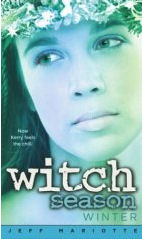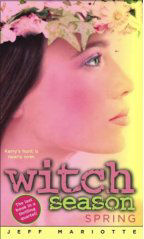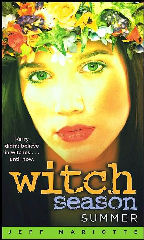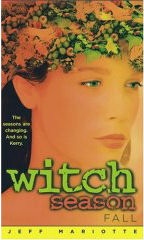SF: Peter David! Iíve read many of his novels. How did he get involved?
†
JM: He's a long-time Buffy/Angel fan, and while I wasn't around at IDW when it happened, I think he contacted them after he heard they got the license.
†
SF: Iím sure youíve heard this question a few times already, but do you want to introduce Buffy into the comics?
†
JM: Besides the fact that itís a separate license, still held by Dark Horse, I think that while it would be fun to bring Buffy in from time to time, if she was around too much sheíd overshadow Angel. Heís popular, but sheís more so, and I think theyíre both strongest when theyíre kept at a distance from each other. Of course, there are those fans who believe that Buffy and Angel are meant solely for each other and can never be happy apart, and they would disagree with me.
†
SF: How has it been to work with Joss Whedon, the creator of Angel, and what exactly is the level of his involvement?
†
JM: Jossís involvement has mostly been to decide which direction he wants the comics to take. Initially I pitched both miniseries ideas at once, and he was the one who wanted to start with the Angel solo story, then move to the story that features more of the cast members. I know a lot of fans would rather have had it the other way around, but Joss is kind of a master at confounding the expectations of fans and making it work out, so I humbly bow to his wisdom.
†
SF: You have actually worked quite extensively with comics in your career. How did you first get started?
†
JM: I was managing a bookstore in La Jolla, CA, and the woman who became my assistant manager was the wife of Jim Lee, one of the most popular and celebrated comics artists in the history of the medium. I was writing a little—a short story here, some journalism there—and she was keeping up with what I was doing and showing it to Jim. When the bookstore chain closed all its southern California locations and I suddenly needed a new gig, Jim called me up. He had recently started his own publishing company, the part of Image Comics that came to be called WildStorm Productions, and needed some text written for trading cards. He knew I could write, so he asked me to do that. One thing led to another and I ended up working for him full time in a marketing capacity. But I still wanted to write, and every now and then an opportunity came up—a couple of Sourcebooks, the script to Union #2, the script to Gen13 #2. After a while I was doing my own stories, and then creating my own titles.
†
SF: Is there that quintessential comic that you dream about creating?
†
JM: Not really. I think Iíve done that with Desperadoes, one of the very few Western comics on the stands today. The characters are near and dear to my heart. The stories are absolutely the kind of thing, mixing Westerns and horror, that I would do if I could do anything at all, so I think Iíve achieved that goal. As long as I get to keep doing Desperadoes stories every year or two Iíll be happy.
†
SF: Desperadoes sounds similar to Stephen Kingís Dark Tower series. Were you at all inspired by those books?
†
JM: Not really. I've only ever read the first two, and Desperadoes is much more traditionally Western than those. There's a long history of horrific/supernatural stuff set in the old west, from the old Jonah Hex comics (and the newer ones by Joe Lansdale), Ghost Rider, and lots more.
†
SF: Anime and manga have become very popular in the States and continue to gain fans everyday. Does this success help the comic book industry? Has there been an increase in the demand for comic books in the last few years?
†
JM: I donít think the anime and manga explosion has helped traditional comics at all. They have sucked a lot of money out of retailersí checkbooks to fill their shelves with more anime and manga, but those things havenít driven readers to traditional American-style comics, nor have the profits the retailers have made from anime and manga allowed them to expand their traditional comics offerings. There are hundreds of new manga books every month, with prices in the $10 range, and even if youíre selling a lot of them, itís an expensive proposition to keep restocking. Iím glad itís helping comic stores stay in business, and it would be nice if the people going into those stores for manga were also buying American comics, but I donít think itís happening to a great extent.
†
SF: What can be done to increase the interest in the American comic? It used to be a thriving business.
†
JM: If I knew the answer to that I'd probably still be working in the business, running Marvel or DC. A lot of the early 90s boom was artificial inflation caused by speculators who had been moving around from coins to comics to cards, etc., looking for something that would appreciate fast and make them a lot of money. I guess they're all buying real estate now. Unfortunately for them, a lot of what happened was that comics that sold a million copies or more didn't become valuable, because there were just so many of them.
†
SF: Switching to your craft, what are the differences in your approach to writing a comic versus a novel? What are the strengths and limitations of each form?
†
JM: With a novel, the most significant thing is that you have a lot more room to tell the story. Comics are a kind of poetryóyou traditionally have 22 pages in an issue, with maybe 6 or 6 or 7 panels per page. In those panels, you have to squeeze the dialogue, but it canít hide the artwork or the reader wonít know whatís happening. So dialogue has to be spare but evocative, and the writer has to learn to let the artist do most of the storytelling.
†
No such restrictions with a novel. You can, if you choose, spend 75 pages in the head of a character as he peruses the items for sale at the supermarket. I donít know how many people would buy your next novel, but stranger things have happened.
†
On the other hand, when comics are really clicking, when thereís a true meeting of creative visions between writer and artist—as an example, Iíll cite Desperadoes #5, from the first miniseries, which is when John Cassaday and I were both, I think, at the top of our games—then you come up with a finished product that is greater than you could have done alone. The art and the story complement each other in a unique way, and the best novelist on Earth couldnít create richer word pictures.
†
I prefer writing novels, to be honest, and being the sole creative force driving the thing. But collaborating with amazing artists like Cassaday and John Severin is a real treat and I wouldnít trade those experiences for anything.
†
SF: You have written stories set in the universes of Angel, Star Trek, Buffy the Vampire Slayer, Charmed, CSI: Miami, The Shield, and Andromeda. How did you first get involved in writing for these franchises?
†
JM: My first novel was a tie-in based on the comic book Gen13, which I had written some issues of. The publisher originally asked Christopher Golden to do the book, and Chris asked me to play along. I was trying to get into doing novels anyway, and had been looking for something to do with Chris, so we collaborated on that one. At around the same time Chris was one of the first two writers to work on Buffy novels, along with our mutual friend Nancy Holder. After the first Gen13 book was published, I had satisfied the minimum requirement of one published novel that was needed for the Buffy program, and when the editor asked Chris for a recommendation of someone who could do a novelization for her, he passed on my name. I wrote The Xander Years, Vol. 2, and then I was a Buffy writer. Then Nancy, Maryelizabeth Hart, and I did the second nonfiction Watcherís Guide, the episode guide for the series, and the Angel line started up. I did some Angels, eventually becoming the most prolific Angel novelist. Most of the other stuff grew out of that, as I became better known in the world of licensed fiction.
†
SF: I understand that you are working on some Conan the Barbarian novels to be published in the future. What types of books are you writing and when can we expect to see them in stores?
†
JM: The books I did are part of a new series called The Age of Conan, which are stories set in Conansís Hyborian Age but not involving him as a main character. There are three adult trilogies and one young adult trilogy, and I did the young adult one. The overall trilogy title is Marauders. Conan appears in a couple of scenes, but mostly itís the story of two Aquilonian teenagers and the ďsavageĒ Pict they wind up befriending. It sprawls across almost the whole Hyborian world, from the Pictish wilderness to Stygia to Cimmeria. Iíve been a Robert E. Howard fan since high school, so the chance to play in that sandbox and make a small contribution of my own was too much to pass up. The books will come out in 2006.
†
SF: Of all the licensed fiction you have written, which experience do you find most memorable?
†
JM: There are memorable aspects to all of it, because I like to do books based on properties that I enjoy. Some of the fringe benefits are fun, like getting to visit the CSI: Miami set to present copies of the first CSI: Miami graphic novel to cast members (and to be filmed doing it for Access Hollywood), and getting to interview Michael Chiklis, CCH Pounder, and Shawn Ryan for The Shield. Iíve attended lots of Buffy/Angel events and met some great people.
†
SF: What are the difficulties in achieving your artistic vision within the boundaries of someone elseís universe?
†
JM: I always approach licensed fiction with respect for the original characters and universe—these things are popular with lots of people, many more, in the case of even marginally successful TV shows, than ever read any given novel. As a writer, I have to remember that Iím playing with someone elseís toys, and I have to return them in the condition they were in when I got them. So while I might be tempted from time to time to hook up Angel and Faith, for instance, or to kill one of the sisters in Charmed for dramatic effect, I know that if I do that then I have to have a good way of returning things to the status quo by the end of the book. But I can create new characters for those books and hook them up or kill them, so thatís how I get around it.
†
SF: With your various ties to licensed fiction, is there any possibility that you might end up writing for television? Is that something you would be interested in?
†
JM: Itís highly unlikely. Iíve gotten to meet some brilliant TV producers, like Anthony Zuiker of CSI and Joss Whedon, but Iíve also seen how hard their staff writers work. I prefer sitting here on the ranch and churning out the pages, versus putting in the 90-hour weeks that a TV writer sometimes has to do on a weekly series. If more shows were written by freelancers, then I might try one sometime, but since most of them are staff-writtenóand the good ones almost have to be, because you canít know the ins and outs of the character arcs unless youíre on the sceneóI donít see it happening.
†
SF: You have also written original books—The Slab and the Witch Season series. How differently did you approach these works versus your licensed fiction?
†
JM: As I said before, I approach licensed books with respect for the original creations. I try to stay true to the characters as theyíve been defined. The difference with original novels is that I was the one who defined the characters in the first place, and I have the freedom to mess with them at will. If some of them donít survive my interference, so be it. I donít really write differently for licensed versus original—in fact, there are probably greater differences between The Slab and the Witch Season books because Witch Season is a young adult series and The Slab is very adult. Not that I talk down, or ďwrite downĒ for younger readers, but the situations are less extreme and the language less graphic.
†
SF: What other original novels can we expect from you in the years to come?
†
JM: I have a proposal for a new young adult fantasy novel out right now, and Iím working on a proposal for an adult dark fantasy series. Iím also churning over, in my mind, a large-scale thriller. Until these are firmed up, though, I donít want to go into any detail about them. Suffice to say that, as usual with me, there are supernatural elements, death and destruction, and good times galore.
†
SF: Iím fond of asking authors with whom they would like to collaborate, if anyone. You have collaborated with authors on various projects over your career. How do you approach that process, and, if you could collaborate with anyone you wanted, who would it be?
†
JM: Generally, my collaborations have followed a similar process—agree up front on a detailed proposal, and then split the work according to whatever has been agreed to. Sometimes itís ďI do this chapter, you do the next.Ē Sometimes itís bigger chunks than that—Iíll do five chapters, he does two, or I do the parts set in the desert and sheíll do the ones set on the island. We play to our strengths. When itís all over, then we both make a final pass, smoothing out the prose so it reads like one voice.
†
JM: Iíd love to collaborate with Stephen King, because heís got a brilliantly imaginative mind and Iíd make more money on one book than in the rest of my career combined. Iíd also like to collaborate with William Goldman, because heís one of the best plotters in the business, and I think working on a book with him would be a wonderful learning experience.
†
SF: What authors have inspired you the most?
†
JM: Besides the aforementioned, Iíd have to say: Wallace Stegner, James Lee Burke, Ross Macdonald, Irwin Shaw. Others would no doubt come to me if I thought about it longer, but these are the ones that leap to mind first.
†
SF: What are you reading right now?
†
JM: Cities of Gold, by William K. Hartmann. Itís a fascinating mixture of historical and contemporary, set in the region of the Flying M Ranch, and Iím learning lots of local history from it. Hartmann is a brilliant guy—an astronomer responsible for, among other things, the most commonly accepted theory of the origin of the moon (he has an asteroid named after him), a painter specializing in space art, a photographer, and a fine novelist.
†
SF: Jeff, is there anything else you would like our readers at Far Sector SFFH to know?
†
JM: Iím currently working on a series of novels based on the comic book 30 Days of Night, with Steve Niles, who wrote the original comics. These are vampire stories with a very rich mythology—real creepy stuff. The first one should be on sale in December, from Pocket Books. And the trade paperback of Desperadoes; Banners of Gold is on sale in August. People can watch my website at http://www/jeffmariotte.com, and my blog at http://jeff_mariotte.typepad.com/my_weblog/, for details.






